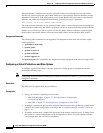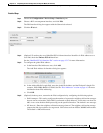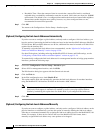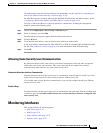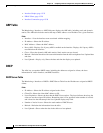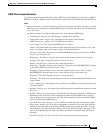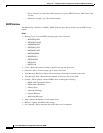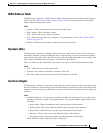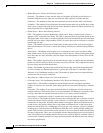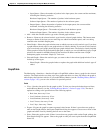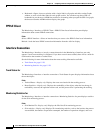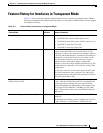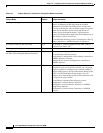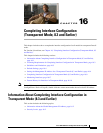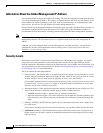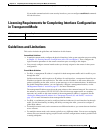
15-26
Cisco ASA 5500 Series Configuration Guide using ASDM
Chapter 15 Completing Interface Configuration (TransparentMode, 8.4 and Later)
Monitoring Interfaces
–
Buffer Resources—Shows the following statistics:
Overruns—The number of times that the ASA was incapable of handing received data to a
hardware buffer because the input rate exceeded the ASA capability to handle the data.
Underruns—The number of times that the transmitter ran faster than the ASA could handle.
No Buffer—The number of received packets discarded because there was no buffer space in the
main system. Compare this with the ignored count. Broadcast storms on Ethernet networks are
often responsible for no input buffer events.
–
Packet Errors—Shows the following statistics:
CRC—The number of Cyclical Redundancy Check errors. When a station sends a frame, it
appends a CRC to the end of the frame. This CRC is generated from an algorithm based on the
data in the frame. If the frame is altered between the source and destination, the ASA notes that
the CRC does not match. A high number of CRCs is usually the result of collisions or a station
transmitting bad data.
Frame—The number of frame errors. Bad frames include packets with an incorrect length or
bad frame checksums. This error is usually the result of collisions or a malfunctioning Ethernet
device.
Input Errors—The number of total input errors, including the other types listed here. Other
input-related errors can also cause the input error count to increase, and some datagrams might
have more than one error; therefore, this sum might exceed the number of errors listed for the
other types.
Runts—The number of packets that are discarded because they are smaller than the minimum
packet size, which is 64 bytes. Runts are usually caused by collisions. They might also be caused
by poor wiring and electrical interference.
Giants—The number of packets that are discarded because they exceed the maximum packet
size. For example, any Ethernet packet that is greater than 1518 bytes is considered a giant.
Deferred—For FastEthernet interfaces only. The number of frames that were deferred before
transmission due to activity on the link.
–
Miscellaneous—Shows statistics for received broadcasts.
–
Collision Counts—For FastEthernet interfaces only. Shows the following statistics:
Output Errors—The number of frames not transmitted because the configured maximum
number of collisions was exceeded. This counter should only increment during heavy network
traffic.
Collisions—The number of messages retransmitted due to an Ethernet collision (single and
multiple collisions). This usually occurs on an overextended LAN (Ethernet or transceiver cable
too long, more than two repeaters between stations, or too many cascaded multiport
transceivers). A packet that collides is counted only once by the output packets.
Late Collisions—The number of frames that were not transmitted because a collision occurred
outside the normal collision window. A late collision is a collision that is detected late in the
transmission of the packet. Normally, these should never happen. When two Ethernet hosts try
to talk at once, they should collide early in the packet and both back off, or the second host
should see that the first one is talking and wait. If you get a late collision, a device is jumping
in and trying to send the packet on the Ethernet while the ASA is partly finished sending the
packet. The ASA does not resend the packet, because it may have freed the buffers that held the
first part of the packet. This is not a real problem because networking protocols are designed to
cope with collisions by resending packets. However, late collisions indicate a problem exists in
your network. Common problems are large repeated networks and Ethernet networks running
beyond the specification.



